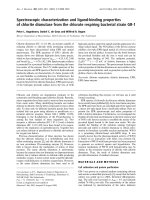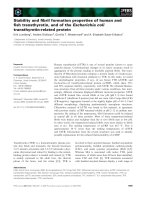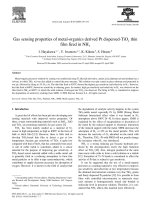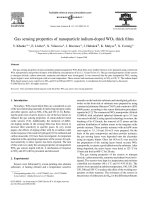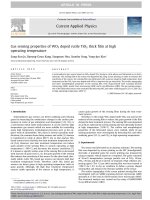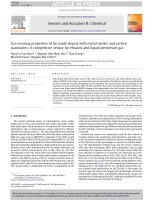- Trang chủ >>
- Khoa Học Tự Nhiên >>
- Vật lý
electrical and gas - sensing properties of wo3 semiconductor material
Bạn đang xem bản rút gọn của tài liệu. Xem và tải ngay bản đầy đủ của tài liệu tại đây (134.26 KB, 6 trang )
Electrical and gas-sensing properties of WO
3
semiconductor material
Wang Yu-De
*
, Chen Zhan-Xian, Li Yan-Feng, Zhou Zhen-Lai, Wu Xing-Hui
Department of Materials Science and Engineering, Yunnan University, Kunming 650091, People's Republic of China
Received 28 November 2000; received in revised form 22 January 2001; accepted 19 February 2001
Abstract
In this paper, the electrical and gas-sensing properties of calcined tungsten trioxide semiconductor materials were
investigated. X-ray diraction, scan electron microscopy and infrared were used to characterize structure and perfor-
mance of WO
3
semiconductor material. The average grain size of WO
3
was 22 nm after calcination at less than 800°C
and 24±26 nm at more than 900°C for 1 h. The sensors of indirect heating type were fabricated. The eects of calcining
temperature and operating temperature on electrical resistance and sensitivity, and sensitivity-gas concentration
properties of the WO
3
-based sensors were investigated. The sensor based on WO
3
exhibited high sensitivity and good
response characteristics to ethanol gas. The electrical properties of WO
3
were analyzed and the sensitive mechanism was
discussed. Ó 2001 Elsevier Science Ltd. All rights reserved.
Keywords: WO
3
; Gas-sensing properties; Calcination temperature; Operating temperature; Sensitivity
1. Introduction
Numerous metal oxide semiconductor materials were
reported to be usable as semiconductor gas sensors, such
as ZnO, SnO
2
,WO
3
, TiO
2
, a-Fe
2
O
3
and so on. These
candidates have non-stoichiometrics structures, so free
electrons originating from oxygen vacancies contribute
to electronic conductivity [1]. The demands for accurate
and dedicated sensors to provide precise process control
and automation in manufacturing process, and also to
monitor and control environmental pollution, have ac-
celerated the development of new sensing materials and
sensors technology over the last decade [2,3]. Some new
types of sensing materials are still being studied and
exploited at present time. WO
3
is n-type semiconductor
whose electron concentration is determined mainly by
the concentration of stoichiometric defects such as oxy-
gen vacancy like other metal oxide semiconductors [4].
WO
3
gas sensor was ®rst reported for detection of H
2
by
Shaver [5], who showed that the conductivity of WO
3
®lms changed greatly upon the exposure to the H
2
am-
bient. Following this pioneering work, many works have
been performed on the structural, electrical properties
and sensing characteristics of WO
3
®lms. It was dem-
onstrated by dierent authors that WO
3
-based thin and
thick ®lms were both sensitive to NO
x
gas [1,4,6±10]. It
has been reported that WO
3
materials have good sensi-
tivity for low concentration of NO
x
gas [6]. However,
most reports focused on the NO
x
gas sensors, and the
study of sensing to other gases was rare. In this paper,
we have investigated the electrical and gas-sensing
characteristics of WO
3
semiconductor material to other
gases such as ethanol, petrol, butane and methane. The
experimental results indicated that the sensor based on
WO
3
exhibited high sensitivity and good response
characteristics to ethanol gas. The electrical and gas-
sensing mechanism were analyzed and discussed.
Solid-State Electronics 45 (2001) 639±644
*
Corresponding author. Present address: Department of
Materials Science and Engineering, Tsinghua University, Beij-
ing 100084, People's Republic of China. Tel.: +86-0871-
5033371; fax: +86-0871-5031410.
E-mail address: (W. Yu-De).
0038-1101/01/$ - see front matter Ó 2001 Elsevier Science Ltd. All rights reserved.
PII: S 0 038-1 101 ( 0 1)0 0 1 26- 5
2. Experimental
2.1. Materials
All the chemical reagents used in the experiments
were purchased from commercial sources as guaranteed-
grade reagents and used without further puri®cation.
The purity of WO
3
powder was 99.99%.
2.2. Characterization of samples
The crystal structures of WO
3
samples were analyzed
using X-ray diraction (XRD, Rigaku D/MAX-3B
powder diractometer). In order to obtain high resolu-
tion and to minimize the signal to noise ratio, we have
performed the measurements with ®xed slits. The mean
crystallite sizes (D) were measured from XRD peaks that
were obtained at a scan rate of 2° min
À1
. D is based on
the Scherrer's equation: D k=DW cos h. Where k is
the wavelength of X-ray (k 1:5418
A), h the Bragg's
diraction angle, and DW the true half-peak width. The
microstructure of powder was characterized by scan
electron microscopy (SEM, CSM950). The conductance
type of the WO
3
was measured with the hot probe.
2.3. Fabrication of sensor elements
In order to prepare series of sensors, we have chosen
the indirect heating type as the structure of sensor. The
sensor were fabricated according to the literature [11].
WO
3
semiconductor materials with SiO
2
(4 wt.%) were
fabricated on an alumina tube with Au electrodes and
Platinum wires. The SiO
2
was used to add intensity of
sensitive material of WO
3
, but it did not in¯uence the
gas-sensing properties of WO
3
-based sensor. A Ni±Cd
alloy crossing alumina tube was used as a resistor. This
resistor ensured both substrate heating and temperature
control. Each element was sintered at dierent temper-
ature (350±800°C) for 1 h in air. Thickness of the sen-
sitive bodies after sintering was approximately 0.6±0.8
mm.
2.4. Measurement of sensing properties
The gas-sensing properties were examined in a
chamber through which air or a sample gas (petrol,
methane, butane and ethanol diluted with air) was al-
lowed to ¯ow at a rate of 160 cm
3
/min. The sensor's
resistance was measured by using a conventional circuit
in which the element was connected with an external
resistor in series at a circuit voltage of 10 V. The elec-
trical response of the sensors was measured with an
automatic test system, controlled by a personal com-
puter. In order to improve their stability and repeat-
ability, the gas sensors were aged at 250°C for 150 h in
air. The gas sensitivity (b) was de®ned as the ratio of the
electrical resistance in air (R
a
) to that in gas (R
g
).
3. Results
3.1. Structure of samples
The average grain size of WO
3
was 22 nm after cal-
cination at less than 800°C and 24±26 nm at more than
900°C for 1 h. The X-ray powder diraction patterns of
the WO
3
powder calcined at 500°C are indexed as
monoclinic and triclinic WO
3
compounds, which have
shown high degree of crystallinity (Fig. 1). Their particle
sizes based on Scherrer's equation are 21 nm. The av-
erage particle sizes of SEM show consistency with the
results of XRD. With the increasing of calcining tem-
perature, WO
3
powder was crystallized with sharp
peaks, the size of grains and macro pores gradually in-
creased. According to the examined results by the hot
probe, WO
3
is n type semiconductive material. This re-
sult is in good accordance with the literature [4].
3.2. Resistance±temperature characteristics
Fig. 2 shows resistance±calcination temperature
curves for the WO
3
-based sensor in the air. The resis-
tance of sensor appeared the largest value for low calc-
ining temperature and the smallest value for high
calcining temperature at the operating temperature of
200°C and 250° C, respectively. As shown in Fig. 3, the
resistance±operating temperature properties of the sen-
sor shows the characteristic of a typical surface-con-
trolled model [12±14]. Electron concentration of WO
3
semiconductor is determined mainly by the concentra-
tion of stoichiometric defects such as oxygen vacancy
like other metal oxide semiconductors. From 100°Cto
Fig. 1. X-ray powder diraction pattern of WO
3
calcined at
500°C for 0.5 h (a) monoclinic WO
3
( b) triclinic WO
3
.
640 W. Yu-De et al. / Solid-State Electronics 45 (2001) 639±644
300°C, the shape of their resistance±operating temper-
ature curves is attributed to the change in charge state of
the chemisorbed oxygen-related species, such as O
À
2ads
,
O
À
ads
,OH
À
ads
and O
2À
ads
. However, above 300°C their in-
trinsic defects, such as oxygen vacancies are responsible
for the conductance of the sensor. Generally, a higher
sintering temperature is needed during the fabrication of
gas-sensing elements, and gas sensors have to operate in
the temperature range from 200°C to 400°C for a long
time [15]. So it is important for gas sensor to have good
thermal stability. In Fig. 3, it can be seen that the eect
of operating temperature from 175°C to 225°C on re-
sistance of WO
3
sensor is smaller than that of the other
temperatures. So that sensor's resistance changed little
in this temperature range, and the sensor based on WO
3
has good thermal stability when their operating tem-
peratures are in this range. This thermal stability is of
signi®cance to apply the sensors to certain control and
monitoring.
3.3. Gas-sensing properties
In this study, we ®rst examined the eect of calcining
temperature on gas-sensing properties of sensor. It was
found that the calcining temperature has great in¯uence
on the sensitivity of the sensor to the sample gases, such
as ethanol, petrol, and butane. Fig. 4 shows the gas
sensitivity to the sample gases changes as a function of
calcination temperature for WO
3
-based sensors at 200°C
operating temperature. It can be clearly realized that
there are an increase in sensitivity for ethanol (100 ppm)
gas as the calcining temperature increasing from 350°C
to 500°C, and the sensitivity decreased above 550°C. It is
seen from the above results that as the calcination
temperature increase, the crystallite size increases,
thereby decreasing the surface area, which in turn af-
fected the gas sensitivity. In order to maintain the
crystallite size, WO
3
sensor calcined at 500°C has been
chosen, since this is the temperature at which the max-
imum sensitivity is obtained for ethanol gas.
It is clear from Fig. 5 that the operating temperature
has an obvious in¯uence on the sensitivity of sensor to
Fig. 2. The resistance±calcination temperature behavior of the
WO
3
-based sensor in air at operating temperature (a) 200°C
and (b) 250°C.
Fig. 3. The relation between the resistance and operating
temperature in ambient humidity air.
Fig. 4. The in¯uence of calcinations temperature on the sensi-
tivity gas concentration 100 ppm).
Fig. 5. The in¯uence of operating temperature on the sensi-
tivity of the sensor for ethanol and petrol 100 ppm, and for
butane and methane 1000 ppm.
W. Yu-De et al. / Solid-State Electronics 45 (2001) 639±644 641
sample gases. The maximum sensitivity to 100 ppm
ethanol gas occur at 80°C is about 40. However, sensi-
tivities to ethanol is reduced with the increasing of op-
erating temperature in the range of 80±200°C. On the
other hand, the sensitivity of sensor to other gases such
as petrol, butane and methane is very low, though gas
concentration is 1000 ppm.
Fig. 6 shows the relationship between sensitivity and
sample gases concentration for sensor operating at
200°C (because sensor has good thermal stability at this
temperature). When the sensor is operated at 200°C, the
sensitivity exhibits a good dependence on ethanol gas
concentration. Long time stability of the WO
3
sensor in
the whole investigated time rang is shown in Fig. 7.
4. Discussion
4.1. Electrical properties
The oxygen adsorbed on the surface of the material
in¯uences the conductance of the WO
3
-based sensor.
The oxygen adsorbed depends on the particle size, large
speci®c area of the material, and the operating temper-
ature of the sensor. With increasing temperature in air,
the state of oxygen adsorbed on the surface of WO
3
undergoes the following reactions:
O
2gas
6 O
2ads
O
2ads
e
À
6 O
À
2ads
O
À
2ads
e
À
6 2O
À
ads
O
À
ads
e
À
6 O
2À
ads
The oxygen species capture electrons from the ma-
terial, leading to increasing of the hole concentration
and decreasing of the electron concentration. WO
3
is a
kind of the acidic oxide and can react with the alkali.
Besides the state of oxygen adsorbed on the surface of
WO
3
, there is OH
À
that comes from water. The exis-
tence form of chemisorbed water on WO
3
is more
complicated. The reaction can be summarized as
W
lat
H
2
O 6W
lat
À OH
À
H
ads
where W
lat
is Lewis acid site, which can form covalent
bond with OH
À
,H
ads
is the adsorbed hydrogen ion,
which is Bronsted acid site that is can be removed easily
in catalytic reaction. OH
À
,O
À
2ads
and O
À
ads
are dominat-
ing oxygen-related species on materials surface at low
temperature [16,17]. As shown in Fig. 3, from room
temperature to 175°C, the resistance decreases with in-
creasing of the operating temperature because the ther-
mal energy causes electrons to emit from low energy
levels (such as donor levels or valence band) to con-
duction band. In the range of 175±225°C, the change in
resistance is very small. It is because the electrons of
donor level are ionized completely, and the electronic
concentration of intrinsic exciting is less than the con-
centration of donor in this temperature region. How-
ever, when the temperature is higher than 250°C,
chemisorbed water desorbs and transfers to O
À
ads
and
O
2À
ads
. The resistance starts to go up in the temperature
ranging from 250°C to 300°C, which may be attributed
to such electron depletive type mechanisms [15].
4.2. Gas-sensing mechanism
The gas-sensing mechanism is based on the changes
in the conductance of WO
3
. The reducing gas reacted
with oxygen adsorbed on the surface of the sensor and
the possibility of the reaction between reducing gas and
lattice oxygen was very small. The reducing gas acting
on the WO
3
sensor surface can be explained as [18]:
R O
À
ads
6 RO e
À
To maintain neutrality, the electrons release back WO
3
material, resulting in the increase of the electron con-
Fig. 6. The eects of gas concentration on the sensitivity of
sensor at 200°C.
Fig. 7. Long time stability of the sensitivity for ethanol
gas concentration 100 ppm).
642 W. Yu-De et al. / Solid-State Electronics 45 (2001) 639±644
centration and the decrease of the resistance. This
change of the electrical resistance determined sensitivity
of the WO
3
based sensor to reducing gases. The reacting
products of C
2
H
5
OH on the surface of WO
3
were
studied by infrared (IR, Mattson ALPHA CENTAURT
FT-IR) spectrum. As shown in Fig. 8, it is found that
C
2
H
5
OH is decomposed to ethyl ether at 250°C but
peaks of aether vanished at 400°C. Ethylene is produced
at 350°C and the amount of it increases with tempera-
ture. Ethanol is adsorbed and reacted with Lewis acid
site of surface (that is W ion) to produce O±CH
2
±CH
3
.
The possible process of the reaction can be explained as
follows:
where O±CH
2
±CH
3
is negatively charged and H
ads
is
activated.
2H
ads
O
À
ads
3 H
2
O
gas
H
ads
OH
À
ads
3 H
2
O
gas
H
ads
O
2À
lat
3 O
lat
±H
À
V
O
where V
O
is oxygen vacancy. At high temperature
350°C, O±CH
2
±CH
3
and OH group form ethylene
through dehydration and the reaction product of eth-
ylene increases with temperature. The reaction can be
written as
If temperature is low and oxygen is de®cient, two
O±CH
2
±CH
3
can interact to produce ethyl ether:
Fig. 8. IR spectrum of ethanol after reacting with WO
3
material at (a) 145°C, (b)200°C, (c) 250°C, (d) 295°C, (e) 350°C, (f) 407°C, (g)
455°C, (h) 500°C.
W. Yu-De et al. / Solid-State Electronics 45 (2001) 639±644 643
All these reactions release electrons into the WO
3
ma-
terial, leading to the increase of the electron concentra-
tion, and the decrease of the resistance of WO
3
-based
sensor. This result is in good accordance with the above
analysis.
5. Conclusions
Monoclinic and triclinic WO
3
compounds can be
used as a gas-sensing material for ethanol gas. The
analysis of the electrical properties and gas-sensing
mechanism of WO
3
-based sensors revealed that the
calcining and operating temperature of sensor obviously
in¯uence on the resistance change and gas sensitive
characteristics of the WO
3
sensor. At calcining temper-
ature of 500°C and operating temperature of 200°C, the
gas sensors based on WO
3
has good thermal stability,
sensitivity and response characteristics to ethanol gases.
Acknowledgements
This work was supported by the Natural Science
Foundation of Yunnan Province, China.
References
[1] Chung YK, Kim MH, Um WS, Lee HS, Song JK, Choi
SC, Yi KM, Lee MJ, Chung KW. Gas sensing properties
of WO
3
thick ®lm for NO
2
gas dependent on process
condition. Sensors Actuators B 1999;60(1):49±56.
[2] Phani AR, Manorama S, Rao VJ. Preparation, character-
ization and electrical properties of SnO
2
based liquid
petroleum gas sensor. Mater Chem Phys 1999;58(2):101±8.
[3] Wang YD, Wu XH, Zhou ZL. Novel high sensitivity and
selectivity semiconductor gas sensor based on the p+n
combined structure. Solid-State Electron 2000;44(9):1603±
7.
[4] Yang JI, Lim H, Han SD. In¯uence of binders on the
sensing and electrical characteristics of WO
3
-based gas
sensors. Sensor Actuators B 1999;60(1):71±7.
[5] Shaver PJ. Activated tungsten oxide gas detectors. Appl
Phys Lett 1967;11:255±7.
[6] Akiyama M, Tamaki J, Miura N, Yamazoe N. Tungsten
oxide-based semiconductor sensor highly sensitive to NO
and NO
2
. Chem Lett 1991;237(9):1611±4.
[7] Sberveglieri G, Depero L, Groppeli S, Nelli P. WO
3
sputtered thin ®lms for NO
x
monitoring. Sensors Actuators
B 1995;26(1±3):89±92.
[8] Tomchenko AA, Khatko VV. WO
3
thick ®lms as sensitive
elements of NO sensors. Proceedings of the 11th European
conference on Solid-State Transduccers Eurosensors XI,
Warsaw, Poland; 21±24 September 1997. p. 79±82.
[9] Tomchenko AA, Khatko VV, Emelianov II. WO
3
thick
®lms gas sensors. Sensors Actuators B 1998;46(1):8±14.
[10] Lee DS, Han SD, Huh JS, Lee DD. Nitrogen oxides-
sensing characteristics of O
3
-based nanocrystalline thick
®lm gas sensor. Sensors Actuators B 1999;60(1):57±63.
[11] Moseley PT. Materials selection for semiconductor gas
sensors. Sensors Actuators B 1992;6(1±3):149±56.
[12] Takata M, Tsubone D, Yanagida H. Dependence of
electrical conductivity of ZnO on degree of sintering. J
Am Ceram Soc 1976;59(1±2):4±8.
[13] Martinelli G, Carotta MC. Sensitivity to reducing gas as a
function of energy barrier in SnO
2
thick-®lm gas sensor.
Sensors Actuators B 1992;7(1±3):717±20.
[14] Gutierrea FJ, Ares L, Robla JI, Horrilo MC, Sayago I,
Agapito JA. Properties of polycrystalline gas sensors based
on d.c. and a.c. electrical measurements. Sensors Actuators
B 1992;8(3):231±5.
[15] Zhang TS, Hing P, Yang L, Zhang JC. Selectivity detection
of ethanol vapor and hydrogen using Cd-doped SnO
2
-
based sensors. Sensors Actuators B 1999;60(2±3):208±15.
[16] McAleer JF, Moseley PT, Norris JU, Williams DE. Tin
dioxide gas sensors: aspects of the surface chemistry
revealed by electrical conductance variations. J Chem Soc
Faraday Trans 1987;I 83(4):1323±46.
[17] Ghiotti C, Chiorino A, Martinelli G, Carotta MC.
Moisture eects on pure and Pd-doped SnO
2
thick ®lms
analysed by FTIR spectroscopy and conductance mea-
surements. Sensors Actuators B 1995;25(1±3):520±4.
[18] Chu XF, Liu XQ, Wang GZ, Meng GY. Preparation and
gas-sensing properties of nano-CoTiO
3
. Mater Res Bull
1999;34(10/11):1789±95.
644 W. Yu-De et al. / Solid-State Electronics 45 (2001) 639±644
